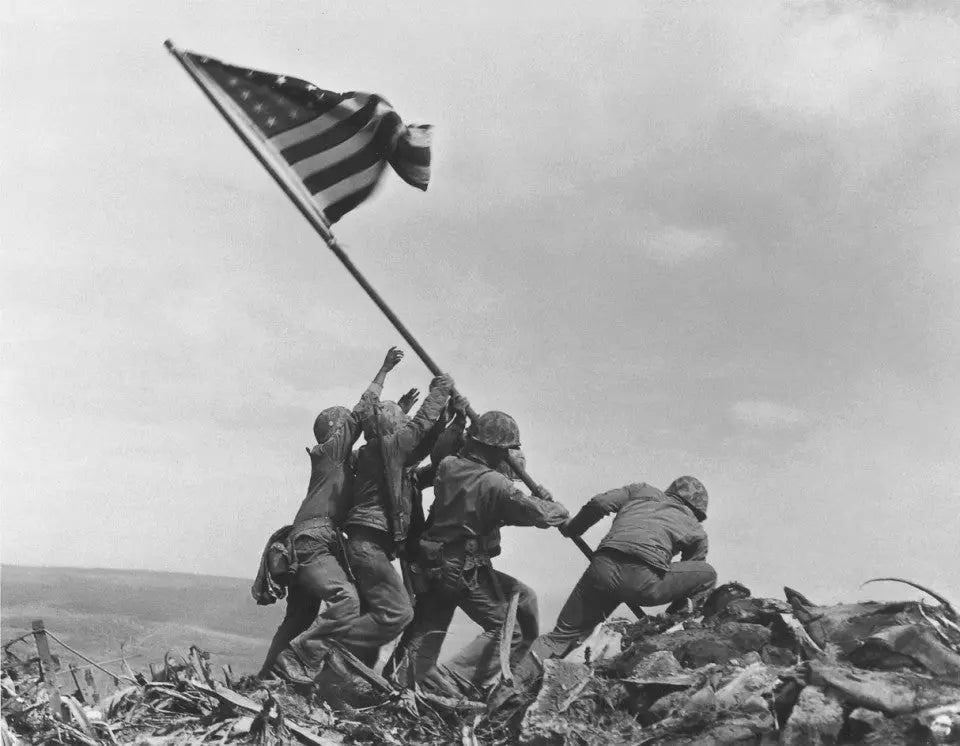With purchase of a Flagpole or Flagpole Kit until Labor Day!

“The Marine history will record Iwo Jima as high as any in their many gallant actions across the Pacific. I have two vivid memories: the fury of their D-Day assault and the thrill of the lofty flag-raising episode [at Mount Suribachi on Iwo Jima]… The Marines were magnificent.”
—Joe Rosenthal, Associated Press
An Island Worth Fighting For
Nestled about 700 miles southeast of Japan, Iwo Jima featured three airfields which made it a prime target for U.S. planners. Seizing those runways would deny Japanese forces a forward base to harass B-29 bombers headed to targets on mainland Japan—and provide the Americans with a critical refueling and emergency landing spot for their own escort fighters.
[Photo: Iwo Jima on a Map of Much of the Pacific War Theater]
What followed—from February 19 to late March 1945—was one of the fiercest and bloodiest battles in the Pacific Theater over the course of the entire war. Some 21,000 Japanese defenders, dug into elaborate underground bunkers and tunnel networks, fought with fanatical resolve. When the smoke cleared, nearly all of them—about 17,800—lay dead, and only around 200 surrendered. Against that, almost 29,000 U.S. Marines became casualties, including roughly 6,000–7,000 killed. But while the U.S. casualty count was indeed chilling, ultimately, for every American KIA, three Japanese soldiers never went home.
[Photo: Japanese Soldiers Lying Dead on Iwo Jima]
The Push Toward Mount Suribachi
General Holland “Howlin’ Mad” Smith’s Marines secured a beachhead on Iwo Jima on February 19 under a relentless naval bombardment—and even more intense kamikaze attacks on the supporting U.S. fleet. But despite the island’s volcanic terrain and kamikaze threat, Japanese infantry initially held back, their leadership relying on hidden artillery and poison gas wells instead of foot soldiers to accomplish their deadly work.
[Photo: D-Day, Iwo Jima-Style]
The next morning, U.S. troops pushed inland, yard by bloody yard, into a labyrinth of pillboxes, machine-gun nests, and—by now—suicidal charges made by Japanese infantry. On February 23, five days into the battle, a Marine reconnaissance patrol reported that Mount Suribachi’s summit appeared unguarded. By 10:30 AM, after knocking out dozens of Japanese surface defensive and braving sniper fire, the first Marines crested the 550-foot volcanic cone. Their achievement wasn’t won easily—it reflected days of hard-fought, close-quarters combat among a network of tunnels and positions designed to bleed the attackers dry.
[Photo: A Japanese Infantry Charge]
The First Flag—and the Second
Once Suribachi fell, Marine Sergeant Joseph Lowery photographed other Marines raising an American flag on a length of captured Japanese pipe. News of Lowery securing those images quickly reached AP photographer Joe Rosenthal, who was already making his way up the slope to capture similar pictures of his own. But from a nearby U.S. ship, Navy Secretary James Forrestal had seen the American flag fluttering proudly atop Mount Suribachi and ordered that first flag to be presented to him as a trophy.
[Photo: AP Photographer Joe Rosenthal]
Unfazed, Rosenthal and a handful of Marines mounted Suribachi themselves with a larger, 8 × 4⅔-foot Stars and Stripes. Their plan? Swap out the first flag for the second in a somewhat dramatic manner. That second banner—and six determined Marines—would be the subjects of Rosenthal’s now-legendary snapshot.
[Photo: The 8 x 4⅔-foot U.S. Flag Shown in Rosenthal’s Famous Photograph]
Capturing an Icon
At roughly 1 PM on February 23, Rosenthal steadied himself atop a sandbag “podium” he’d hastily arranged. He recalled later that he almost missed the moment altogether—he was busy building his makeshift stand when the Marines began to hoist the second flag. By Rosenthal’s account, it was luck more than timing that allowed this 32-year-old AP photographer to capture six figures angling their bodies toward the sky, their obvious strain interfering not at all with the Marines’ resolve to stand the U.S. flag as straight and tall as possible.
[Photo: Joe Rosenthal’s “Raising the Flag on Iwo Jima”]
Rosenthal always downplayed his role in both the incident and at Iwo Jima more generally—“The Marines took Iwo Jima, I just took the picture,” would become his oft-spoke chorus to admirers—but he had prepared for hours, climbed Mount Suribachi alongside battle-worn Marines, and anticipated that history would unfold again at the summit. Winning the Pulitzer Prize for Photography in 1945, “Raising the Flag on Iwo Jima” is remarkable for the way in which the workmanlike postures of the Marines raising the American flag on Suribachi’s summit mirror the well-known workmanlike—and certainly bravado eschewing—attitudes of both the Marines most responsible for winning the War in the Pacific against Japan and patriotic members of the American public throughout the U.S. involvement in World War II.
[Photo: A U.S. Marine Recruitment Poster Employing an Adaptation of Rosenthal’s Photograph]
Six Faces, One Flag—and a Lasting Legacy
Remarkably, the identities of the six men in the photograph weren’t confirmed until 2019, and three of them were killed in action on Iwo Jima just days later. Yet that is part of what makes their image so poignant: theirs was a makeshift ceremony carried out with no guarantee of safety for those performing it, a replacement flag that was never meant to be permanent, and ordinary, quite mortal Marines rising to embody a collective American spirit which was proving impossible for the Japanese to kill.
“Raising the Flag on Iwo Jima” quickly became far more than a moving battlefield snapshot or a Pulitzer Prize winner. It captured a turning point in the war—and distilled the American ideals of perseverance and sacrifice into a single, unforgettable frame. Decades on, it still stands as perhaps the most iconic image in U.S. history, reminding us that even in our darkest hours, we find strength in the unity and hope represented so beautifully by the Stars and Stripes.
[Photo: The US Marine War Memorial]
Further Reading:
Lucas, Dean. (2007). “Raising the Flag on Iwo Jima.” Famous Pictures Magazine.
Office of the U.S. Marine Corps Communication. (2016). “USMC Statement on Marine Corps Flag Raisers.” U.S. Marine Corps.
Rosenthal, Joe. (2025). Joe Rosenthal and the flag-raising on Iwo Jima.
The Pulitzer Prizes.
Stilwell, Blake. (2021). “The Story Behind the Two Flag Raisings at the Battle of Iwo Jima.” Military.com.
Toland, John. (2003). The Rising Sun: The Decline and Fall of the Japanese Empire, 1936-1945. Random House.
Wright, Derrick. (2004). Iwo Jima 1945: The Marines Raise the Flag on Mount Suribachi. Osprey Publishing.

